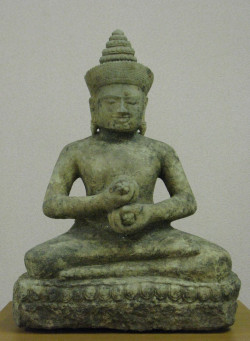ค้นหางานศิลปกรรม
ฐานข้อมูลศิลปกรรมในเอเชียตะวันออกเฉียงใต้
พระไภษัชยคุรุ
คำสำคัญ :
| ชื่อเรียกอื่น | พระวัชรธร |
|---|---|
| ชื่อหลัก | พิพิธภัณฑสถานแห่งชาติ ร้อยเอ็ด |
| ประเภทงานศิลปะ | ประติมากรรม |
| ตำบล | ในเมือง |
| อำเภอ | เมือง |
| จังหวัด | ร้อยเอ็ด |
| ภาค | ภาคตะวันออกเฉียงเหนือ |
| ประเทศ | ไทย |
| พิกัดภูมิศาสตร์ ค่าองศาทศนิยม | Lat : 16.053993 Long : 103.657342 |
| พิกัดภูมิศาสตร์ พิกัดกริด | Zone : 48 Q Hemisphere : N E : 356384.28 N : 1775350.85 |
| ตำแหน่งงานศิลปะ | จัดแสดงภายในพิพิธภัณฑสถานแห่งชาติ ร้อยเอ็ด |
| ประวัติการสร้าง | ไม่ปรากฏหลักฐานเอกสารที่เกี่ยวข้องกับประวัติการสร้างโดยตรง แต่จากการค้นพบภายในกู่แก้วซึ่งเป็นศาสนสถานประจำอโรคยศาลที่พระเจ้าชัยวรมันที่ 7 โปรดให้สร้างขึ้น และรูปแบบเทียบได้กับประติมากรรมในศิลปะเขมรแบบบายน จึงสันนิษฐานได้ว่าประติมากรรมองค์นี้ควรสร้างขึ้นในช่วงพุทธศตวรรษที่ 18 รัชกาลพระเจ้าชัยวรมันที่ 7 ประติมากรรมในลักษณะนี้ค้นพบอยู่ตามศาสนสถานประจำอโรคยศาลหลายแห่ง มีรูปแบบและขนาดโดยรวมเป็นแบบเดียวกัน จึงน่าเชื่อว่าทั้งหมดสร้างขึ้นพร้อมกันจากนั้นจึงถูกส่งมาประดิษฐานตามศาสนสถานประจำอโรคยศาลหลังต่างๆ |
|---|---|
| กระบวนการสร้าง/ผลิต | หินทรายแกะสลัก |
| ประวัติการอนุรักษ์ | ค้นพบที่กู่คันธนาม ตำบลยางคำ อำเภอโพนทราย จังหวัดร้อยเอ็ด ศาสนสถานแห่งนี้เป็นศาสนสถานประจำอโรคยศาล |
| ลักษณะทางศิลปกรรม | ประติมากรรมอยู่ในอิริยาบถนั่งขัดสมาธิราบบนฐานหน้ากระดานที่ประดับลายกลีบบัว พระพักตร์สี่เหลี่ยม สวมมงกุฎอันประกอบด้วยกระบังหน้าและรัดเกล้ากรวยซ้อนชั้น สวมกุณฑลทรงตุ้มแหลม พระกรกายช่วงบนเปล่าเปลือย พระหัตถ์แต่ละข้างถือวัชระโดยวางซ้อนกันบริเวณพระอุทร |
| ข้อมูลที่สำคัญทางวิชาการ | ประติมากรรมที่มีลักษณะแบบนี้ยังเป็นที่ถกเถียงทางวิชาการว่าควรหมายถึงทิพยบุคคลองค์ใด จากการที่ถือวัชระในพระหัตถ์ทั้งสองซึ่งวางอยู่ในตำแหน่งพระอุทรทำให้หลายท่านเชื่อว่าเป็นรูปของพระวัชรธร อันเป็นภาคปรากฏของพระอาทิพุทธเจ้า ผู้สูงสุดในคติพุทธศาสนามหายาน อย่างไรก็ตามประติมากรรมแบบนี้ค้นพบได้มากมายตามศาสนสถานประจำอโรคยศาล ทำให้หลายท่านสันนิษฐานว่าเป็นพระไภษัชยคุรุ ผู้เป็นพระพุทธเจ้าแห่งการแพทย์ในคติพุทธศาสนามหายาน |
| ข้อสังเกตอื่นๆ | ปัจจุบันยังเป็นที่ถกเถียงทางวิชาการว่าประติมากรรมแบบนี้ควรเป็นทิพยบุคคลใดแน่ ข้อสันนิษฐานแรกที่แพร่หลายให้ความเห็นว่าน่าจะเป็นพระวัชรธรอันเป็นภาคปรากฏของพระอาทิพุทธเจ้า ซึ่งเป็นพระพุทธเจ้าสูงสุดในคติพุทธศาสนามหายาน โดยให้เห็นผลว่าประติมากรรมนี้ถือวัชระในพระหัตถ์ทั้งสองข้างละ 1 เล่มในตำแหน่งพระอุทร คล้ายกับรูปพระวัชรธรที่พบแพร่หลายในดินแดนที่พุทธศาสนามหายานรุ่งเรือง เช่น ธิเบต เนปาล ข้อสันนิษฐานที่สองซึ่งยังไม่แพร่หลายมากนักให้ความเห็นว่าน่าจะเป็นพระไภษัชยคุรุ ผู้เป็นพระพุทธเจ้าแห่งการแพทย์ในคติพุทธศาสนามหายาน โดยให้เห็นว่าประติมากรรมแบบนี้พบได้ตามศาสนสถานประจำอโรคยศาล หรือศาสนสถานประจำสถานพยาบาล หลายแห่งมีจารึกระบุชัดเจนว่าพระเจ้าชัยวรมันที่ 7 โปรดให้สร้างขึ้น ทั้งยังมีเนื้อหาบางส่วนกล่าวสรรเสริญพระไภษัชยคุรุด้วย จึงเชื่อว่าศาสนสถานประจำสถานพยาบาลควรประดิษฐานพระไภษัชยคุรุเป็นประธาน เมื่อประติมากรรมรูปบุคคลถือวัชระในพระหัตถ์แบบนี้ค้นพบตามศาสนสถานประจำอโรคยศาล จึงทำให้นักวิชาการเกิดความเชื่อว่าน่าจะเป็นรูปพระไภษัชยคุรุ |
| ยุค | ประวัติศาสตร์ |
| สมัย/รูปแบบศิลปะ | ลพบุรี, เขมรในประเทศไทย, บายน |
| อายุ | พุทธศตวรรษที่ 18 |
| ศาสนา | พุทธ |
| ลัทธิ/นิกาย | มหายาน |
| งานศิลปะที่เกี่ยวข้อง | ประติมากรรมถือวัชระจากศาสนสถานประจำอโรคยศาลอื่นๆ เช่น ประติมากรรมจากกู่แก้ว อำเภอเมือง จังหวัดขอนแก่น |
| รูปแบบลิขสิทธิ์ | Attribution-NonCommercial-NoDerivs (CC BY-NC-ND) |
|---|---|
| เจ้าของสิทธิ์ | ศูนย์มานุษยวิทยาสิรินธร (องค์การมหาชน) |
| วันที่จัดทำข้อมูล | 2016-09-30 |
| ผู้จัดทำข้อมูล | รุ่งโรจน์ ธรรมรุ่งเรือง |
| บรรณานุกรม | รุ่งโรจน์ ภิรมย์อนุกูล. “ประติมานวิทยาของรูปเคารพในสุคตาลัย ศาสนสถานประจำอโรคยศาล” เมืองโบราณ, ปีที่ 40, ฉบับที่ 3 (กรกฎาคม-กันยายน 2557), หน้า 108-121. รุ่งโรจน์ ภิรมย์อนุกูล. “อโรคยศาล ความรู้ทั่วไปและข้อสังเกตเบื้องต้น” เมืองโบราณ, ปีที่ 30, ฉบับที่ 3 (กรกฎาคม-กันยายน 2547), หน้า 15-53. |


